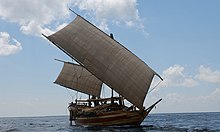Kaep
Kaep is a traditional type of double-ended Proa sailboat native to Palau.[1][2] Some of the essential design elements have also been adopted as a modern smaller multihull prototype variant.[A]
Larger context
The
Additionally, there is an important and fundamental dividing line between two design types. Some vessels "shunt", that is they change course direction by using the opposite pole of a two pole mast then sailing in the opposite direction (the "
History
Developed in Palau and used for centuries, the kaep was built from tree logs. A keel carved to a knife's edge was combined with a deep bow, giving it the ability to function in severe adverse weather, wind and waves. Sailors would crowd aft, lifting the bow out of the water, and increasing hull speed. It was used to fish, race and trade.[1] It is a very fast craft.[1]
The kaep lacks a
A traditional kaep is double-ended with a reversible or pivoted (swiveling) mast, so that it can be sailed in either direction.[2][4]
A traditional kaep has an average hull 10 m (33 ft) in length, 35 cm (14 in) in width, and maximum height of 90 cm (35 in).[2][5]
The kaep has been the subject of
See also
References
Notes
Citations
- ^ a b c d e Smith, Basil (1985). "Palau Racing Canoe". Fleetwood® Trains & Boats & Planes & More Collection Description Card. Archived from the original (Painting) on January 26, 2016. Retrieved January 18, 2016.
- ^ a b c d e f g Louis, Jean. "Pacific islands sailing canoes". webring.com. Retrieved January 18, 2016.
- ^ Toulouse, France: Kaep Diffusion Sarl. Retrieved January 18, 2016.
The Kaep is a high performance ultra light proa fitted with an easily manageable windsurf rig of 5 sq. mtr.
- ISBN 978-1860648397.
- ^ "Kaep Palau". Historiche Proas - Ancient Outriggers (in German). Retrieved January 18, 2016.
External links
- "Kaep Palau". Historiche Proas - Ancient Outriggers. Retrieved January 18, 2016.
- "Prao Kaep {prototype}" (Video). YouTube. January 7, 2008. Retrieved January 18, 2016.






